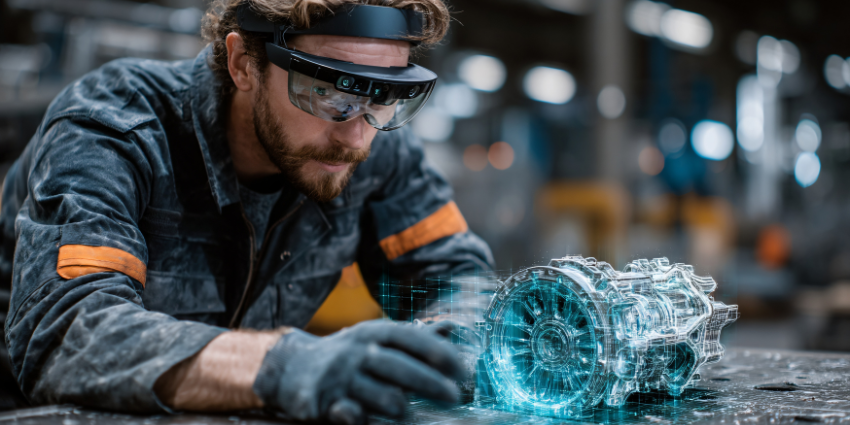XR can reshape work – but only if it solves a business pain loud enough to be heard in the boardroom.
Despite plenty of XR trials and one-time experiences, the long-term adoption of its practice relies on actual results: outcomes, scale, and trust. Today, XR is maturing, being used in training, quality assurance, engineering and tourism to name a few.
Related Articles
- What Enterprises Can Learn from Public Sector XR Success
- Ford’s CEO is Right: AR can be a ‘Game Changer’ for Blue-collar Workers
- How to Support and Manage XR in the Workplace
XR Hits Fifth Gear
Without results, XR remains in the trial era. So how can the relationship between XR and businesses exceed the honeymoon period?
Across industries, a pattern is emerging – XR works when it tackles specific, high-value business friction. This is proven in the public sector.
At Daimler Trucks North America, (f.k.a. Freightliner) the approach starts with people, not technology. Immersive technologies lead Laura Kinkle believes in having users and employees involved in the process of implementing XR as early as possible. When employees help shape this process, an understanding is built. Adoption follows naturally, and problems meet solutions faster. This results into the ‘wow’ factor fading quickly and XR integration becoming sustainable.
Meanwhile, Ford offers a masterclass in scaling from PoC to production. The automaker once ran half a dozen XR pilots with little success – until it redefined what a ‘trial’ meant. According to Muhammad Anwar, Technology Lead for Extended, Virtual, and Augmented Reality, PoC’s shouldn’t be considered as trials or evaluations but as “foundation[s] of future deployments.”
This proven successful mindset shift drove Ford to bake scalability and stability into every test drive, aligning XR with enterprise IT standards from the start. This isn’t the first time Ford has shown its love for XR, with its CEO labelling augmented reality as a “game-changer.”
Connectivity, device management, and firmware updates (often afterthoughts in early pilots) became critical success factors. Today, Ford’s XR systems are globally deployable because they were treated like infrastructure, not innovation theatre.
Volvo Group followed a similar path, using management platforms like ArborXR to control hundreds of Meta Quest headsets across 80 countries. That global reach transformed XR from ‘demo-room tech’ to a distributed workforce asset. With a single dashboard, Volvo’s digital team can push updates, manage permissions, and deploy immersive content worldwide – all at enterprise scale.
XR Off-road
XR success is occurring outside the car industry also. Take GE Aerospace, where augmented reality is helping scale technician training.
As AR Program Leader Nic Sabo explains, focusing the narrative on capacity, not just cost, moves the conversation beyond experimentation. If immersive tools can train 50% more technicians annually, that boost in throughput delivers far more value than marginal savings. The end result is faster operational readiness, whilst cheaper training is met along the way: a win-win.
The same logic applies across sectors. At FedEx, VR training modules simulate real logistics workflows, allowing new recruits to master complex processes before hitting the warehouse floor. But the key to success, says Nike Adeoye, Advanced Tech Advisor, lies in design empathy:
“Start with the trainers. Understand their pain points. Build the value into that journey.”
The Engine Room
The unsung hero behind successful XR rollouts is not the headset that makes the difference, but the systems and stakeholders that surround it. IT, cybersecurity, data compliance – these are the quiet factors that determine whether a project scales or stalls.
When GE’s XR content took off internally, demand skyrocketed. Without IT support, they couldn’t keep up. With it, they could deliver faster, safer, and smarter. As Sabo summed up:
“Without having that close partnership with IT and understanding what our digital strategy was, we didn’t have a place to really start for scaling.”
The bottom line? Know your objective, integrate support systems and be patient.
Fuel for Thought…
The difference between experiments that fizzle and deployments that scale comes down to discipline, not dazzle. The companies winning with XR treat it like core infrastructure, not a novelty. They build around measurable outcomes, tight IT integration, and human-centered design.
XR’s power lies in amplifying human capability: faster training, fewer errors, better collaboration. As businesses weave these tools into their daily operations, the tech moves from ‘immersive experience’ to indispensable utility.
In short: XR’s not a moonshot anymore – it’s becoming muscle memory for modern industry. The hype is fading, and that’s exactly how real innovation sticks.







